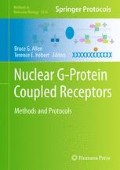Abstract
In adult cardiac myocytes, multiple G protein-coupled receptors (GPCR) localize to and signal at the nucleus. These include endothelin B receptors, angiotensin type 1 and 2 receptors, β1- and β3-adrenergic receptors, and α1A- and α1B-adrenergic receptors. Initiation of signaling through nuclear GPCRs requires that ligands be produced within or transported into the cardiac myocytes, yet mechanisms whereby these ligands are produced or transported into cardiac myocytes are largely unclear. To activate nuclear adrenergic receptors in adult cardiac myocytes, uptake of endogenous catecholamines epinephrine and norepinephrine occurs via organic cation transporter 3 (OCT3), a member of the slc22a family of genes. This chapter details a method to detect and quantify catecholamine uptake in intact adult cardiac myocytes using a fluorescent-based catecholamine uptake assay.
Access this chapter
Tax calculation will be finalised at checkout
Purchases are for personal use only
References
Boivin B, Chevalier D, Villeneuve LR et al (2003) Functional endothelin receptors are present on nuclei in cardiac ventricular myocytes. J Biol Chem 278:29153–29163
Merlen C, Farhat N, Luo X et al (2013) Intracrine endothelin signaling evokes IP3-dependent increases in nucleoplasmic Ca in adult cardiac myocytes. J Mol Cell Cardiol 37:189–202
Lee DK, Lanca AJ, Cheng R et al (2004) Agonist-independent nuclear localization of the apelin, angiotensin AT1, and bradykinin B2 receptors. J Biol Chem 279:7901–7908
Tadevosyan A, Maguy A, Villeneuve LR et al (2010) Nuclear-delimited angiotensin receptor-mediated signaling regulates cardiomyocyte gene expression. J Biol Chem 285:22338–22349
Huang Y, Wright CD, Merkwan CL et al (2007) An alpha1A-adrenergic-extracellular signal-regulated kinase survival signaling pathway in cardiac myocytes. Circulation 115:763–772
Wright CD, Chen Q, Baye NL et al (2008) Nuclear alpha1-adrenergic receptors signal activated ERK localization to caveolae in adult cardiac myocytes. Circ Res 103:992–1000
Wright CD, Wu SC, Dahl EF et al (2012) Nuclear localization drives alpha1-adrenergic receptor oligomerization and signaling in cardiac myocytes. Cell Signal 24:794–802
Boivin B, Lavoie C, Vaniotis G et al (2006) Functional beta-adrenergic receptor signalling on nuclear membranes in adult rat and mouse ventricular cardiomyocytes. Cardiovasc Res 71:69–78
Vaniotis G, Del Duca D, Trieu P et al (2011) Nuclear beta-adrenergic receptors modulate gene expression in adult rat heart. Cell Signal 23:89–98
Vaniotis G, Glazkova I, Merlen C et al (2013) Regulation of cardiac nitric oxide signaling by nuclear beta-adrenergic and endothelin receptors. J Mol Cell Cardiol 37:58–68
Bkaily G, Choufani S, Sader S et al (2003) Activation of sarcolemma and nuclear membranes ET-1 receptors regulates transcellular calcium levels in heart and vascular smooth muscle cells. Can J Physiol Pharmacol 81:654–662
Wu SC, Wright CD, Cypher AL et al (2012) Nuclear targeting of the alpha 1A-adrenergic receptor is required for cardiac myocyte contractility. Circ Res 111:A128
Sugano K, Kansy M, Artursson P et al (2010) Coexistence of passive and carrier-mediated processes in drug transport. Nat Rev Drug Discov 9:597–614
Gray MO, Long CS, Kalinyak JE et al (1998) Angiotensin II stimulates cardiac myocyte hypertrophy via paracrine release of TGF-β1 and endothelin-1 from fibroblasts. Cardiovasc Res 40:352–363
Singh VP, Le B, Bhat VB et al (2007) High-glucose-induced regulation of intracellular ANG II synthesis and nuclear redistribution in cardiac myocytes. Am J Physiol Heart Circ Physiol 293:H939–H948
Singh VP, Le B, Khode R et al (2008) Intracellular angiotensin II production in diabetic rats is correlated with cardiomyocyte apoptosis, oxidative stress, and cardiac fibrosis. Diabetes 57:3297–3306
Singh VP, Baker KM, Kumar R (2008) Activation of the intracellular renin-angiotensin system in cardiac fibroblasts by high glucose: role in extracellular matrix production. Am J Physiol Heart Circ Physiol 294:H1675–H1684
Nies AT, Koepsell H, Damme K et al (2011) Organic cation transporters (OCTs, MATEs), in vitro and in vivo evidence for the importance in drug therapy. Handb Exp Pharmacol 201:105–167
Hayer-Zillgen M, Bruss M, Bonisch H (2002) Expression and pharmacological profile of the human organic cation transporters hOCT1, hOCT2 and hOCT3. Br J Pharmacol 136:829–836
Roth M, Obaidat A, Hagenbuch B (2012) OATPs, OATs and OCTs: the organic anion and cation transporters of the SLCO and SLC22A gene superfamilies. Br J Pharmacol 165:1260–1287
Grundemann D, Gorboulev V, Gambaryan S et al (1994) Drug excretion mediated by a new prototype of polyspecific transporter. Nature 372:549–552
Jonker JW, Wagenaar E, Mol CA et al (2001) Reduced hepatic uptake and intestinal excretion of organic cations in mice with a targeted disruption of the organic cation transporter 1 (Oct1 [Slc22a1]) gene. Mol Cell Biol 21:5471–5477
Schweifer N, Barlow DP (1996) The Lx1 gene maps to mouse chromosome 17 and codes for a protein that is homologous to glucose and polyspecific transmembrane transporters. Mamm Genome 7:735–740
Gorboulev V, Ulzheimer JC, Akhoundova A et al (1997) Cloning and characterization of two human polyspecific organic cation transporters. DNA Cell Biol 16:871–881
Grundemann D, Koster S, Kiefer N et al (1998) Transport of monoamine transmitters by the organic cation transporter type 2, OCT2. J Biol Chem 273:30915–30920
Koepsell H, Lips K, Volk C (2007) Polyspecific organic cation transporters: structure, function, physiological roles, and biopharmaceutical implications. Pharm Res 24:1227–1251
Zwart R, Verhaagh S, Buitelaar M et al (2001) Impaired activity of the extraneuronal monoamine transporter system known as uptake-2 in Orct3/Slc22a3-deficient mice. Mol Cell Biol 21:4188–4196
O’Connell TD, Ishizaka S, Nakamura A et al (2003) The alpha(1A/C)- and alpha(1B)-adrenergic receptors are required for physiological cardiac hypertrophy in the double-knockout mouse. J Clin Invest 111:1783–1791
O’Connell TD, Rodrigo MC, Simpson PC (2007) Isolation and culture of adult mouse cardiac myocytes. Methods Mol Biol 357:271–296
Author information
Authors and Affiliations
Corresponding author
Editor information
Editors and Affiliations
Rights and permissions
Copyright information
© 2015 Springer Science+Business Media New York
About this protocol
Cite this protocol
Dahl, E.F., Wright, C.D., O’Connell, T.D. (2015). Quantification of Catecholamine Uptake in Adult Cardiac Myocytes. In: Allen, B., Hébert, T. (eds) Nuclear G-Protein Coupled Receptors. Methods in Molecular Biology, vol 1234. Humana Press, New York, NY. https://doi.org/10.1007/978-1-4939-1755-6_5
Download citation
DOI: https://doi.org/10.1007/978-1-4939-1755-6_5
Published:
Publisher Name: Humana Press, New York, NY
Print ISBN: 978-1-4939-1754-9
Online ISBN: 978-1-4939-1755-6
eBook Packages: Springer Protocols

